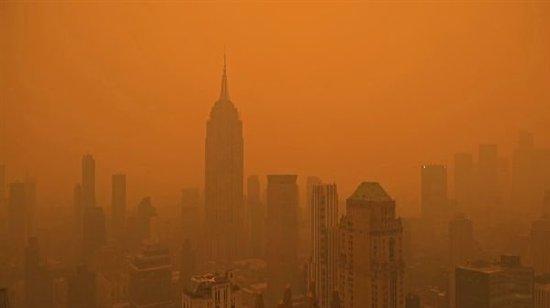全球90%以上兒童每天呼吸有毒的空氣
全球約有93%15歲以下兒童(即18億兒童)每天呼吸遭受嚴重污染的空氣,使他們的健康和發展面臨嚴峻風險。可悲的是,他們當中有許多人因此而死亡:據世界衛生組織(世衛組織)估計,2016年,有60萬名兒童死於因污染空氣引起的急性下呼吸道感染。
▼
空氣污染危害着我們的兒童
世衛組織題爲《空氣污染與兒童健康:清潔空氣是良策》的新報告檢查了室外環境和家庭空氣污染對世界兒童健康的嚴重影響,特別是在低收入和中等收入國家。該報告於世衛組織首次全球空氣污染與健康大會召開前夕發佈。
報告闡明,如果孕婦暴露於受污染的空氣,更可能過早分娩,併產下低出生體重的瘦小嬰兒。空氣污染還會影響神經發育和認知能力,並可能引發哮喘和兒童期癌症。暴露於高水平空氣污染的兒童在以後生命中罹患心血管病等慢性疾病的風險可能更高。
譚德塞博士
世界衛生組織總幹事
“受污染的空氣正在毒害數百萬兒童並毀掉他們的生命。這是不可原諒的。每個兒童都應當能夠呼吸清潔的空氣,這樣他們才能成長並充分發揮其潛力。”
兒童特別容易遭受空氣污染影響的一個原因是,他們的呼吸速度比成人快,因此會吸收更多的污染物。此外,大腦和身體尚處於發育中的兒童的生活空間更接近地面,而一些污染物在此的濃度最高。
在經常使用污染性燃料和技術烹飪、取暖和照明的家庭中,新生兒和幼兒也更容易受到家庭空氣污染的影響。
Maria Neira博士
世衛組織公共衛生、健康問題的環境和社會決定因素司司長
“空氣污染正在阻礙兒童大腦的正常發育,並以超出我們想象的更多方式影響其健康。而其實,我們有許多能減少危險污染物排放的簡單方法。世衛組織正在支持實施有益於健康的政策措施,如加速轉向清潔的烹飪和取暖燃料和技術,鼓勵使用更清潔的交通工具,促進節省能源的住房和城市規劃。我們正在爲低排放發電,更加清潔安全的工業技術和更好的城市廢物管理鋪墊道路。”
主要調查結果
空氣污染影響神經發育,導致認知測試結果偏低,對心理和運動發育具有負面影響。
即使暴露水平較低,空氣污染也會損害兒童的肺功能。
全球15歲以下兒童93%暴露於超出世衛組織空氣質量指南的環境細顆粒物(PM2.5)濃度,他們當中包括6.3億5歲以下兒童和18億15歲以下兒童。
在世界各地低收入和中等收入國家,98%5歲以下兒童暴露於超出世衛組織空氣質量指南的PM2.5濃度。相比之下,在高收入國家,52%5歲以下兒童的暴露量高於世衛組織空氣質量指南。
世界40%以上人口(其中包括10億15歲以下兒童)暴露於主要因使用污染性技術和燃料烹飪而造成的高水平家庭空氣污染。
2016年,大約60萬例15歲以下兒童死亡可歸因於環境和家庭空氣污染的共同影響。
在低收入和中等收入國家,50%以上5歲以下兒童的急性下呼吸道感染病例系由源自烹飪的家庭空氣污染以及環境(外部)空氣污染所導致。
空氣污染是兒童健康的主要威脅之一,五歲以下兒童死亡的近十分之一系由空氣污染所致。
世衛組織首次全球空氣污染與健康大會於10月30日星期二在日內瓦開幕。這次會議將使世界各國領導人;衛生部、能源部和環境部部長;市長;政府間組織負責人;科學家以及其他方面代表有機會針對這一嚴重健康威脅做出行動承諾,這種威脅每年縮短約700萬人的生命。
具體行動應包括:
衛生部門採取行動,向衛生專業人員提供信息、教育和資源,同時積極參與跨部門政策制定。
實施減少空氣污染的政策:所有國家都應努力滿足世衛組織全球空氣質量指南的標準,以加強兒童的健康與安全。爲實現這一目標,各國政府應採取措施,減少全球能源結構中對化石燃料的過度依賴,投資提高能源效率,並促進對可再生能源的利用。更好的廢物管理可以減少社區內燃燒的廢物量,從而減少“社區空氣污染”。專用於家庭烹飪、取暖和照明活動的清潔技術和燃料可以大大改善家庭和周圍社區的空氣質量。
採取措施儘量避免兒童暴露於受污染的空氣,例如使學校和遊樂場遠離繁忙的道路、工廠和發電廠等主要空氣污染源。
針對空氣污染的“生命呼吸”運動:這是在世衛組織、聯合國環境署和減少短期氣候污染物的氣候與清潔空氣聯盟之間建立的一個夥伴關係,旨在提高政府和個人對空氣污染的認識並鼓勵其採取行動。
點擊“閱讀原文”,瞭解更多關於報告的信息!
More than 90% of the world’s children breathe toxic air every day
Every day around 93% of the world’s children under the age of 15 years (1.8 billion children) breathe air that is so polluted it puts their health and development at serious risk. Tragically, many of them die: WHO estimates that in 2016, 600,000 children died from acute lower respiratory infections caused by polluted air.
A new WHO report on Air pollution and child health: Prescribing clean air examines the heavy toll of both ambient (outside) and household air pollution on the health of the world’s children, particularly in low- and middle-income countries. The report is being launched on the eve of WHO’s first ever Global Conference on Air Pollution and Health.
It reveals that when pregnant women are exposed to polluted air, they are more likely to give birth prematurely, and have small, low birth-weight children. Air pollution also impacts neurodevelopment and cognitive ability and can trigger asthma, and childhood cancer. Children who have been exposed to high levels of air pollution may be at greater risk for chronic diseases such as cardiovascular disease later in life.
“Polluted air is poisoning millions of children and ruining their lives,” says Dr Tedros Adhanom Ghebreyesus, WHO Director-General. “This is inexcusable. Every child should be able to breathe clean air so they can grow and fulfil their full potential.”
One reason why children are particularly vulnerable to the effects of air pollution is that they breathe more rapidly than adults and so absorb more pollutants.
They also live closer to the ground, where some pollutants reach peak concentrations – at a time when their brains and bodies are still developing.
Newborns and young children are also more susceptible to household air pollution in homes that regularly use polluting fuels and technologies for cooking, heating and lighting
“Air Pollution is stunting our children’s brains, affecting their health in more ways than we suspected. But there are many straight-forward ways to reduce emissions of dangerous pollutants,” says Dr Maria Neira, Director, Department of Public Health, Environmental and Social Determinants of Health at WHO.
“WHO is supporting implementation of health-wise policy measures like accelerating the switch to clean cooking and heating fuels and technologies, promoting the use of cleaner transport, energy-efficient housing and urban planning. We are preparing the ground for low emission power generation, cleaner, safer industrial technologies and better municipal waste management, ” she added.
Key findings:
Air pollution affects neurodevelopment, leading to lower cognitive test outcomes, negatively affecting mental and motor development.
Air pollution is damaging children’s lung function, even at lower levels of exposures
Globally, 93% of the world’s children under 15 years of age are exposed to ambient fine particulate matter (PM2.5) levels above WHO air quality guidelines, which include the 630 million of children under 5 years of age, and 1.8 billion of children under 15 years
In low- and middle-income countries around the world, 98% of all children under 5 are exposed to PM2.5 levels above WHO air quality guidelines. In comparison, in high-income countries, 52% of children under 5 are exposed to levels above WHO air quality guidelines.
More than 40% of the world’s population – which includes 1 billion children under 15 - is exposed to high levels of household air pollution from mainly cooking with polluting technologies and fuels.
About 600’000 deaths in children under 15 years of age were attributed to the joint effects of ambient and household air pollution in 2016.
Together, household air pollution from cooking and ambient (outside) air pollution cause more than 50% of acute lower respiratory infections in children under 5 years of age in low- and middle-income countries.
Air pollution is one of the leading threats to child health, accounting for almost 1 in 10 deaths in children under five years of age.
WHO’s First Global Conference on Air Pollution and Health, which opens in Geneva on Tuesday 30 October will provide the opportunity for world leaders; ministers of health, energy, and environment; mayors; heads of intergovernmental organizations; scientists and others to commit to act against this serious health threat, which shortens the lives of around 7 million people each year.
Actions should include:
Action by the health sector to inform, educate, provide resources to health professionals, and engage in inter-sectoral policy making.
Implementation of policies to reduce air pollution: All countries should work towards meeting WHO global air quality guidelines to enhance the health and safety of children. To achieve this, governments should adopt such measures as reducing the over-dependence on fossil fuels in the global energy mix, investing in improvements in energy efficiency and facilitating the uptake of renewable energy sources. Better waste management can reduce the amount of waste that is burned within communities and thereby reducing ‘community air pollution’. The exclusive use of clean technologies and fuels for household cooking, heating and lighting activities can drastically improve the air quality within homes and in the surrounding community.
Steps to minimize children’s exposure to polluted air: Schools and playgrounds should be located away from major sources of air pollution like busy roads, factories and power plants.
BreatheLife air pollution campaign: BreatheLife is a partnership of WHO, UN Environment and the Climate and Clean Air Coalition to Reduce Short-lived Climate Pollutants that aims to increase awareness and action on air pollution by governments and individuals.
www.breathelife2030.org
查看原文 >>


















